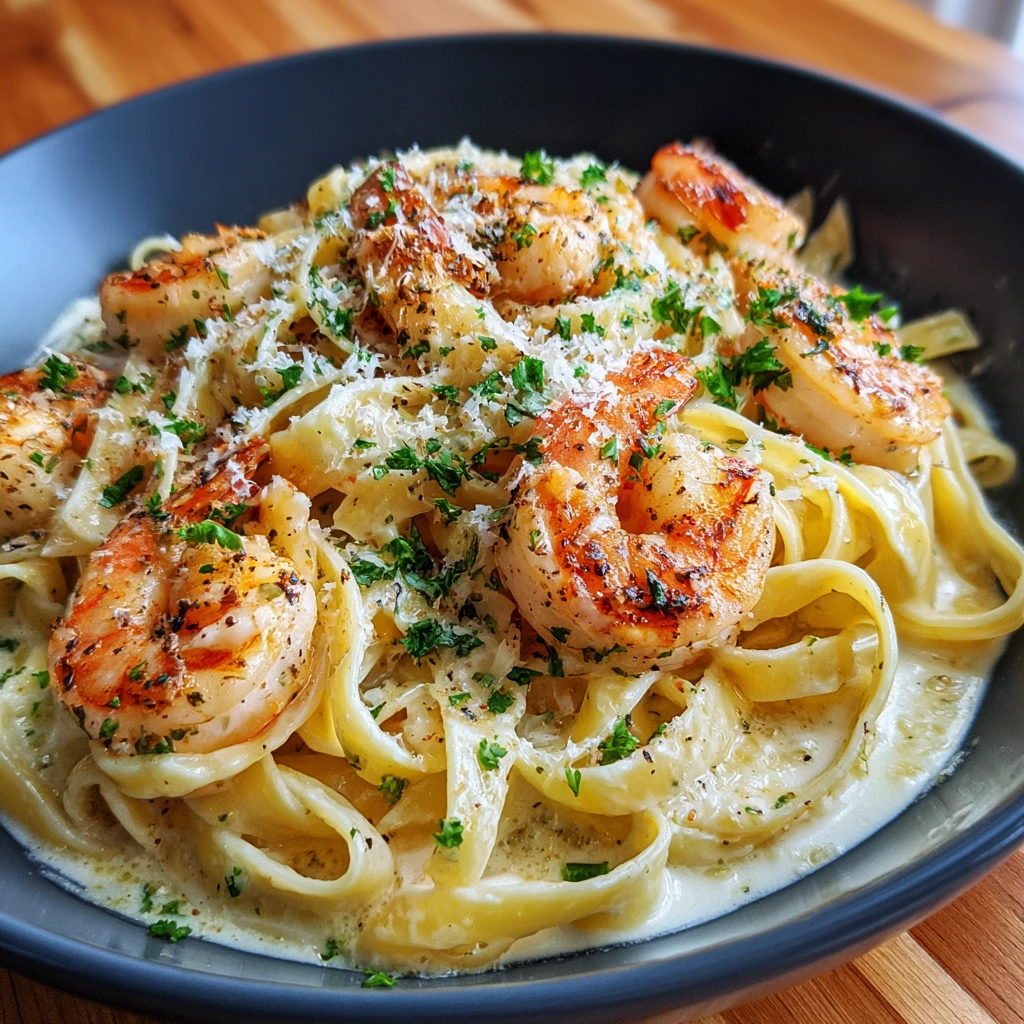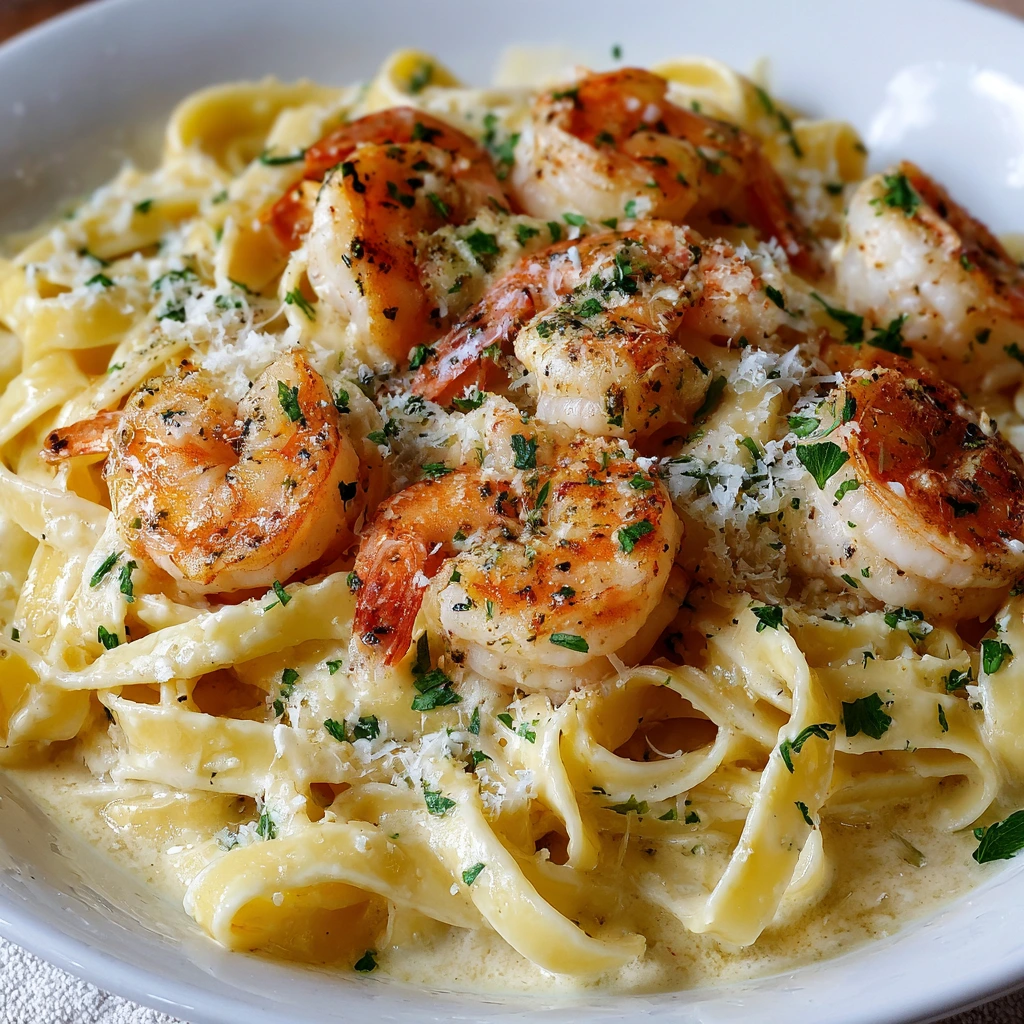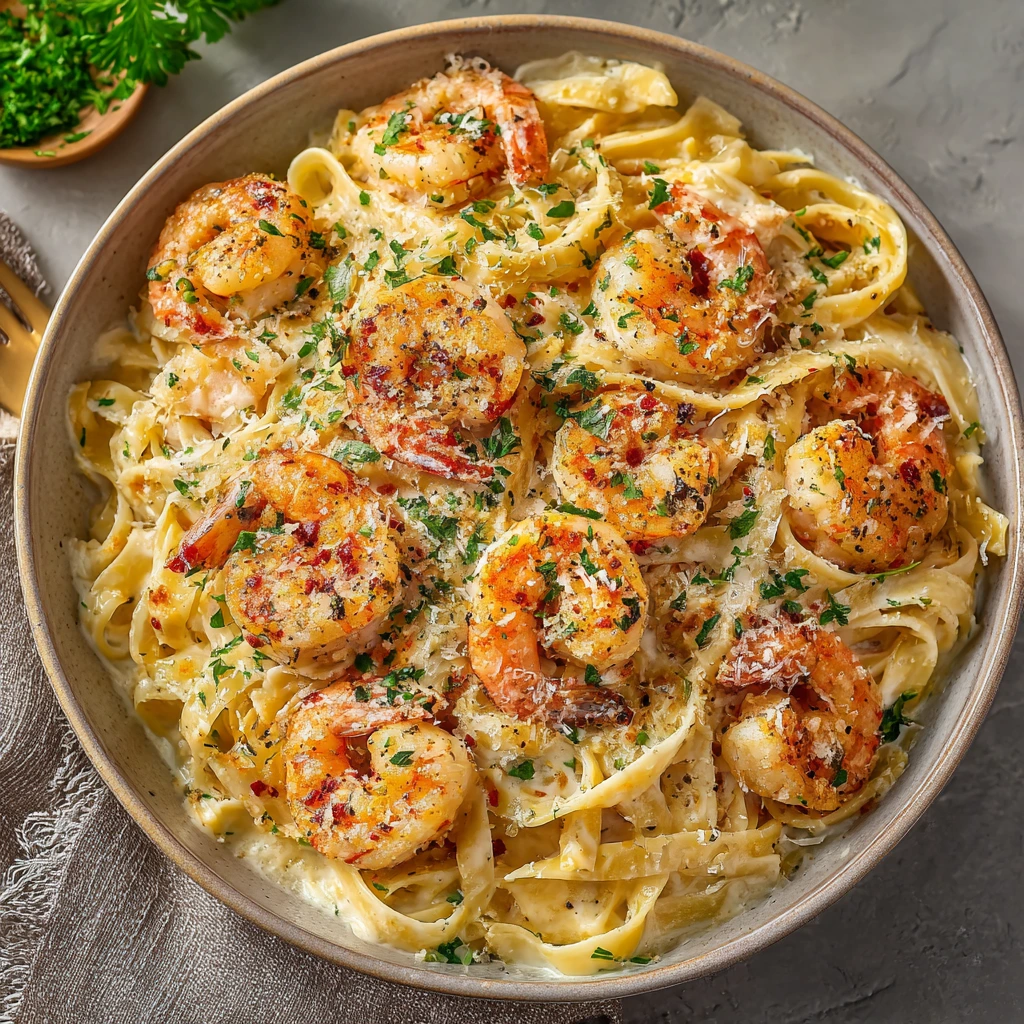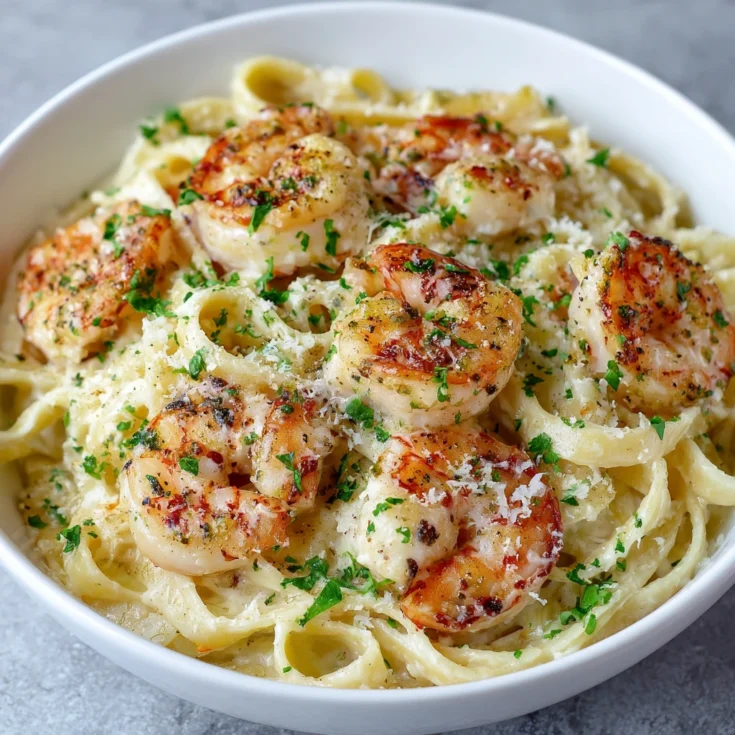Introduction & Hero Overview
Hook & Sensory Opening: Aromatic, Silky, and Irresistible
Imagine the inviting aroma of garlic sizzling gently in butter, mingling with the sweet scent of seared shrimp. Creamy sauce coats every strand of tender fettuccine, offering a velvety texture that melts in your mouth. The bright hint of lemon zest cuts through the richness, delivering a perfect flavor balance that awakens your palate.
What Is Creamy Garlic Shrimp Fettuccine?
Creamy Garlic Shrimp Fettuccine is a luscious pasta dish where succulent shrimp swim in a rich, garlicky cream sauce. This Italian-inspired meal features fettuccine noodles enveloped in a sauce made from garlic, heavy cream, and Parmesan cheese. The shrimp add a sweet, briny bite, creating a satisfying contrast with the smooth sauce. This dish combines simplicity with elegance, making it perfect for both weeknight dinners and special occasions. Its comforting yet sophisticated flavor profile has made it a staple for seafood lovers who want a quick, impressive meal without fuss.
Why It’s Trending and Loved
This dish has soared in popularity because it’s a restaurant-quality meal made easily at home. It requires minimal ingredients and simple steps, yet delivers big on flavor and indulgence. Busy cooks appreciate how fast it comes together, and families love its creamy, rich taste that pleases all ages. Its visual appeal—golden shrimp atop glossy noodles—boosts its social media shareability. Creamy Garlic Shrimp Fettuccine is the perfect blend of convenience and decadence, making it a go-to recipe for anyone craving a satisfying, gourmet pasta experience.

Origins, Variations & Culinary Context
Roots in Fettuccine Alfredo: Classic Roman Inspiration
Creamy Garlic Shrimp Fettuccine draws its roots from the beloved Italian classic, Fettuccine Alfredo. Originating in Rome, this dish originally combined simple ingredients: fresh fettuccine tossed in butter and Parmesan cheese. The creamy texture came naturally from the cheese melting into the pasta. Over time, cooks around the world enhanced this classic by adding heavy cream to create a richer sauce. The addition of shrimp is a modern twist that adds both flavor and protein, transforming a humble dish into a luxurious seafood meal. This evolution reflects how traditional recipes adapt to changing tastes and ingredient availability. The creamy sauce remains the star, delivering silky richness, while the shrimp introduces a fresh, oceanic contrast. This combination offers an elegant fusion of Italian tradition and contemporary flair, perfect for anyone seeking comfort with a gourmet edge.
Global Twists and Cousin Dishes: Exploring Similar Flavors
Around the world, dishes with creamy pasta and shrimp take many forms. Lemon-butter shrimp scampi is a close cousin, showcasing garlic and butter with a bright lemon punch served over pasta like linguine or spaghetti. Unlike creamy sauces, scampi focuses on a lighter, tangy flavor profile but shares garlic’s prominence and succulent shrimp. Pasta primavera offers another relative, combining pasta with fresh vegetables and sometimes seafood, all tossed in a light garlic or cream sauce. These global variations highlight the versatility of pasta dishes featuring garlic and seafood, each with unique flavor balances. They all celebrate fresh ingredients, simple preparations, and bold garlic notes that make these meals satisfying and memorable.
Popular Adaptations: One-Pot Magic and Flavor Boosters
Modern cooks have embraced creative versions of creamy garlic shrimp fettuccine to suit busy lifestyles and diverse palates. One-pot recipes streamline cooking by combining pasta, shrimp, and sauce in a single pan, reducing cleanup and boosting flavor as everything cooks together. Adding sun-dried tomatoes introduces a sweet-tart depth that cuts through the richness, while veggies like spinach, mushrooms, or bell peppers add texture and color. For those craving heat, smoked paprika or red chili flakes bring smoky warmth and a spicy kick, elevating the dish’s complexity. These adaptations prove the recipe’s flexibility, allowing each cook to tailor the dish to their taste preferences or dietary needs without losing the creamy, garlicky essence that defines it.
Ingredients Breakdown & Smart Swaps
Shrimp: Fresh or Frozen, Choosing the Right Size
Selecting the best shrimp is crucial for flavor and texture. Fresh shrimp offers a sweet, briny taste and firm bite. However, high-quality frozen shrimp can be just as good, especially when thawed properly in cold water. Shrimp size matters too—medium to large shrimp work best, as they cook quickly without becoming rubbery. Raw shrimp is preferred because it sears beautifully, developing a golden crust that adds texture and depth to the dish. Pre-cooked shrimp can turn mushy if reheated in the sauce, so always opt for raw for the best results.
Pasta: Fettuccine, Linguine, and Gluten-Free Options
Fettuccine, with its wide, flat ribbons, is ideal for holding creamy sauces, ensuring every bite is coated perfectly. Linguine offers a slightly thinner alternative with a similar shape, while spaghetti provides a rounder texture for those who prefer a classic pasta shape. For gluten-sensitive eaters, gluten-free pasta made from rice, corn, or legumes works well without compromising texture. Just be sure to cook it al dente, as gluten-free pasta can become mushy quickly. The key is selecting pasta that can support the thick, garlicky cream sauce without getting overwhelmed.
Cream Base: Heavy Cream, Half-and-Half, and Clever Hacks
Heavy cream creates the luxuriously rich sauce that defines creamy garlic shrimp fettuccine. Its high fat content ensures a smooth, velvety texture and prevents curdling during cooking. For a lighter option, half-and-half or a mix of milk and heavy cream can reduce calories while maintaining creaminess. If you want to avoid heavy dairy, a popular hack uses milk combined with cornstarch as a thickener. Whisking cornstarch into cold milk before adding it to the sauce helps achieve a creamy consistency without cream’s richness. This trick also works well for those who want a slightly lighter dish or have dietary restrictions but don’t want to sacrifice texture.
Cheese: Parmesan, Manchego, and Dairy-Free Alternatives
Parmesan is the classic choice for creamy garlic shrimp pasta. It adds a nutty, salty depth that complements garlic and shrimp perfectly. Manchego can be a delightful substitute, lending a slightly sharper flavor. For dairy-free diets, nutritional yeast or vegan Parmesan options provide umami richness. These substitutes melt well into the sauce and offer a similar savory finish without dairy, making the dish accessible to those with lactose intolerance or vegan preferences.
Aromatics & Seasoning: Garlic, Shallots, and Zesty Layers
Garlic drives the flavor, and layering it throughout the cooking process builds complexity. Start with finely minced garlic sautéed gently in butter or oil to release sweetness. Shallots add a mild onion note that enhances depth. Smoked paprika or chili flakes bring warmth and subtle heat, balancing the richness of the cream. Lemon zest or a squeeze of lemon juice brightens the sauce, cutting through heaviness with fresh acidity. Together, these aromatics and seasonings create a vibrant, well-rounded flavor profile.
Enhancements & Veggie Extras: Adding Color and Texture
Boost nutrition and taste by adding sun-dried tomatoes, which contribute a sweet and tangy bite. Fresh spinach wilts quickly into the sauce, adding color and mild earthiness. Mushrooms introduce a meaty texture that pairs well with shrimp, while olives offer a salty, briny punch. These extras make the dish more interesting and customizable while complementing the creamy garlic shrimp base perfectly.
Step-by-Step Cooking Process
Prep & Mise en Place: Setting Up for Success
Before cooking, prepare all ingredients to streamline the process. Defrost shrimp by placing them in cold water for about 15 minutes, ensuring they thaw evenly. While waiting, grate fresh Parmesan cheese finely for easy melting. Peel and mince garlic cloves, and finely chop shallots if using. Cook the pasta water last, but once al dente, reserve about a cup of the starchy water before draining. This reserved water will help adjust the sauce’s texture later. Having everything ready upfront ensures a smooth, stress-free cooking experience.
Cooking Shrimp: Perfect Sear and Seasoning
Heat a large skillet over medium-high flame and add a splash of olive oil or butter. Season raw shrimp with salt, pepper, and optional paprika or chili flakes for a subtle kick. Sear the shrimp in a single layer, avoiding overcrowding, which causes steaming instead of browning. Cook shrimp for about 2 minutes per side until they turn pink and develop a light golden crust. Remove shrimp from the pan promptly to prevent overcooking. Cooking in batches helps maintain heat and guarantees a crispy exterior with tender, juicy centers.
Building the Sauce: Creamy, Flavor-Packed Base
In the same pan, reduce heat to medium and add a bit more butter or oil. Sauté minced garlic and shallots gently until fragrant and translucent, about 2 to 3 minutes—avoid browning, which can make garlic bitter. Next, deglaze the pan with a splash of reserved pasta water or broth, scraping up flavorful browned bits. Pour in heavy cream or your chosen substitute, stirring constantly. To thicken, whisk in a small amount of flour or cornstarch dissolved in cold water if needed. Let the sauce simmer gently until it thickens to a silky consistency. Stir in grated Parmesan cheese gradually, allowing it to melt smoothly into the sauce. Taste and season with salt, pepper, and lemon zest or juice for brightness. Adjust thickness by adding more reserved pasta water until the sauce coats the back of a spoon.
Combining Pasta & Sauce: Marrying Flavors and Textures
Cook fettuccine until just al dente following package instructions. Drain pasta but reserve extra cooking water to tweak sauce consistency. Add drained pasta directly to the skillet with the creamy sauce. Toss thoroughly over low heat to ensure every strand is coated with luscious cream. If the sauce feels too thick, slowly add reserved pasta water one tablespoon at a time to loosen it without watering down flavors. This technique creates a smooth, clingy sauce that binds perfectly to the pasta.
Re-adding Shrimp & Finishing Touches: Bringing It All Together
Return the cooked shrimp to the pan, folding them gently into the pasta and sauce. Heat just enough to warm the shrimp through without overcooking. Finish the dish by sprinkling chopped fresh parsley for a burst of color and freshness. Add a final squeeze of lemon juice if desired to elevate brightness and balance richness. These finishing touches elevate the dish’s visual appeal and taste.
Plating & Presentation Tips: Make It Instagram-Worthy
To plate, twirl portions of fettuccine into neat nests using a fork and spoon, creating an elegant mound. Arrange shrimp on top or around the pasta for a balanced look. Sprinkle extra Parmesan and freshly ground black pepper for texture and contrast. Garnish with whole parsley leaves or a light dusting of smoked paprika for color. Serve immediately to enjoy the creamy sauce at its best. Simple presentation techniques transform this comforting meal into a restaurant-style delight.




